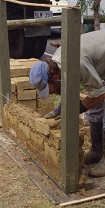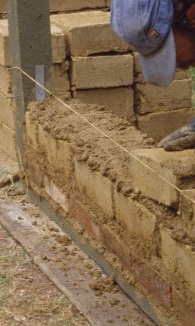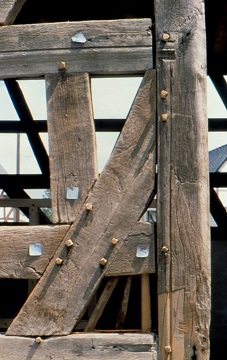Improve your knowledge of
alternative building methods!
 Study by distance
learning and find out more about building healthy, ecologically friendly
and sustainable buildings.
Study by distance
learning and find out more about building healthy, ecologically friendly
and sustainable buildings.
- This
course is suitable for people wanting to build small buildings, such as
sheds, right through to those wanting to build their own homes.
- Learn
more about mud brick construction - this ancient skill is still used
today and can provide safe and sturdy homes.
- Also learn more about temperature, light, making buildings efficiency and the psychological effects of buildings and how these affect human health and well-being.
- Course Duration: 600 hours of self-paced study. Start at any time and study where and when you want to. Full support is provided throughout your studies by knowledgeable and experienced tutors.
Course Structure and Content
 Students are required to complete a total of 6 modules. Study 4 core modules of Healthy Buildings I and II, Mud Brick Construction and Carpentry; then choose 2 elective modules from Environmental Waste Management, Landscape Construction, Project Management, and Starting a Small Business.
Students are required to complete a total of 6 modules. Study 4 core modules of Healthy Buildings I and II, Mud Brick Construction and Carpentry; then choose 2 elective modules from Environmental Waste Management, Landscape Construction, Project Management, and Starting a Small Business.
CORE MODULES
The following 4 Core Modules are to be studied by all students. Summaries of the modules are provided below; for further information on each, please click on the module title to follow the link to the respective pages.
Healthy Buildings I (Healthy Buildings Construction) BSS200
This module looks at the impact of building construction on human physiological and physical health. Through 10 lessons, students will learn about building biology, building diseases, the impact of services, light, colour, ventilation and much more.

Healthy Buildings II (Building Environment & Health) BSS300
The Healthy Buildings II module builds on the knowledge gained in the previous module and also looks at additional areas such as the impact of the location upon health and surroundings to a building. As well as considering the materials used in buildings and, in particular, materials or finishes used, the module looks at additional elements such as the management of interior environments and consulting services that can be offered to clients.
Mud Brick Construction ASS103
This 10 lesson module looks at the processes involved with constructing buildings with alternative materials such as mud bricks. Students will learn about the different materials that may be used and how they are made. The module considers all of the important elements of the building process, from planning and building regulations, through the selection of materials, to site management and the provision of services (water, electricity etc.).
Carpentry BSS100
Carpentry is a 10 lesson module which serves as a solid foundation to carpentry techniques. Students will learn the practical skills of working with wood in such applications as building construction, furniture making, and landscaping. As well as covering techniques, the module looks at all important elements such as selection of tools, methods for joining, finishing, and planning a project.

ELECTIVE MODULES
Students are to choose 2 electives from the list below. Please click on the module title to follow the link to the respect module pages. Or, if you prefer an alternative elective, please contact us on info@acsedu.co.uk to see if this is a suitable module.
Environmental Waste Management BEN202
Through the 6 lessons in this module, students will gain a broad overview of the nature, and scope of waste, and the ways in which it is dealt with in the present day. The module covers domestic waste, and industrial waste. Students will gain an understanding of ways in which waste can be dealt with – whether it can be recycled, or treated, and what chemical or environmental impacts have to be considered.
Landscape Construction BHT111
This is a 10 lesson module through which students will learn how to construct or build a landscape in the correct or appropriate manner. The module includes the planning, and selection of tools and materials, as well as notable factors such as drainage, irrigation, and plant elements. The module concludes with a lesson on suitable workplace safety and management considerations.
Green Walls And Roofs BHT256
Green Walls And Roofs is a 9 lesson module looking at the exciting approaches of introducing greenery into residential, commercial, or public landscapes where space may be at a premium or to improve the aesthetic of environments. Students will learn about the construction of vertical and roof gardens, the materials to use and which plants are most suited to these applications. The module includes a lesson on maintaining these – how plants may be provided with water and the appropriate nutrients, as well as the control of pests or diseases.
Project Management BBS201
The Project Management module comprises 9 lessons. In order to develop a business, or operate within a contractual environment, managers need to possess the skill set that enables them to introduce and manage projects of change. The module covers key areas which include the identification and planning of projects, and the strategy for the implementation of projects. The lessons will impart the knowledge for students to develop their leadership and personnel skills, considering the different types of leadership skills as well as looking at how conflicts and problems may be effectively resolved. The module is concluded with a special assignment where the student will develop a full suite of documentation for a planned project.
Starting a Small Business VBS101
Through 12 lessons, this module introduces you to the world of running a business. Students will learn about the first steps to take – what types of business there are, planning, and marketing a business. As well as learning about forming a business, the module considers all important aspects in lessons including planning, budgeting, and bookkeeping. The module will provide the essentials basics to forming a business and give those studying the pointers to the correct approach to making a success of their venture.
Each lesson is completed with an assignment which is submitted to the school, marked by the school's tutors and returned to the student with any relevant suggestions, comments, and if necessary, extra reading.
EARTH BUILDING IN BOTH WET AND DRY CLIMATES
 Mud walls were used a lot in England in prior to modern times; particularly where other materials are too expensive
for cottages. Earth built walls can be very durable, but may require more maintenance than stone or brick. The skeleton of the cottage would be
formed by upright pieces of timber, about four inches square, placed at a
distance about fifteen inches from each other, and properly braced and tied
together by other horizontal pieces which support the floors and roof. The
upright timbers, strong plastering laths (or sticks), are nailed in a
horizontal direction, and mud or plaster, composed of earth, rather inclining
to clay, mixed with chopped straw is laid over the laths with a trowel. When
the plaster is dry, a thin outer coat of lime and sand is applied over it. The
inside of the building is lathes and sometimes plastered with mud; and
sometimes with lime and hair.
Mud walls were used a lot in England in prior to modern times; particularly where other materials are too expensive
for cottages. Earth built walls can be very durable, but may require more maintenance than stone or brick. The skeleton of the cottage would be
formed by upright pieces of timber, about four inches square, placed at a
distance about fifteen inches from each other, and properly braced and tied
together by other horizontal pieces which support the floors and roof. The
upright timbers, strong plastering laths (or sticks), are nailed in a
horizontal direction, and mud or plaster, composed of earth, rather inclining
to clay, mixed with chopped straw is laid over the laths with a trowel. When
the plaster is dry, a thin outer coat of lime and sand is applied over it. The
inside of the building is lathes and sometimes plastered with mud; and
sometimes with lime and hair.
Those mud walls are best when composed of clay and a large proportion of
sand, in sharp and angular particles: for these angular particles form as it
were, wedges to hold the clay together; and the mud plaster is not so liable to
crack, as when composed of clay mixed up with fine sand”
Source: “Improvisations: traditional low Cost Building
Techniques by John Archer, Second back Row Press, Australia,
1979. “
There can be
many variations in the way a timber framework is created. This early English
account portrays a very orderly approach. At the other end of the scale, it’s
possible to use sticks and branches from trees.
John Mason
(principal of ACS Distance
Education) built an office with three mud brick walls; and one wattle and daub wall (1982 in Victoria, Australia). By creating a mesh work of branches and twigs off Eucalyptus trees. The smallest
twigs were around 0.5cm diameter and the largest branches up to around 8cm
thick. Most were 1-3cm diameter. Most held together by weaving. Any timber that
didn’t hold in position was tied together with some nylon rope or nailed
together. The wall was then plastered following the contours, ins and outs of
the framework. The wall was then painted
with several coats of 1 part bondcrete and 10 parts water on both sides. One
side was the interior of a building (all other walls were mud brick (Yes you
can mix building methods); and the other side an exterior wall. A metal roof
overhang of 0.75 metres helped provide protection from weather. When Mr Mason sold the property in 2003, this
wall had showed no sign of deterioration whatsoever. This wall was built in a
temperate climate with an annual rainfall of around 35 to 40 inches.
A variation of
wattle and daub is to create two timber walls with a cavity in between that is
filled with mud. This type of wall can be either created by completely constructing
the timber walls before filling with mud; or by building the walls step by step
and filling the cavity as the timber parts are increased in height.
Have You Tried Wattle and Daub?
This is one of the fastest methods of mud construction. It has been common and popular in Africa and South America and during gold rushes of the 19th century it was widely used in Australia and the USA. It has also used widely throughout history in many other parts of the world, including Europe. If a wattle and daub wall is reasonably thick (30cm or more) it can last for hundreds of years. Wattle and daub does offer more flexibility in the shapes that can be created in a wall. This method can be good if you want to create a wall with bumps and hollows; perhaps niches or shelves embedded into the wall; or artistic forms (e.g. the shape of a person or animal emerging from the surface of the wall). By constructing rough shapes in timber framework that dip into or protrude from the wall, you can provide a foundation to sculpt the mud plaster over.
One potential problem with wattle and daub can be if pests (e.g. termites) infiltrate and eat out the form work. Once the wall has settled and dried, this may not be a total disaster anyway. The wall may well still hold firm. The possibility should however be considered in areas where termites can be a major problem.
Why Study with ACS?
Design your own learning pathway.
Study at your own pace, from anywhere, at any time.
Receive prompt, expert support from our team of committed and friendly tutors.
Your learning is our priority. We are flexible and adaptable to meet your educational needs!
Enrolling is easy - just go to the top of this page and select your study method and payment option.
If you have any questions about studying with ACS, or want to know more about any of our courses, get in touch with our specialist tutors today. They will be happy to answer your questions and look at different study options to fit in with your goals.